Refraction at Spherical Surfaces and by Lenses
Refraction at Spherical Surfaces and by Lenses: Overview
This topic consists of various concepts like Paraxial Rays,Refraction from Spherical Surface,Lens, etc.
Important Questions on Refraction at Spherical Surfaces and by Lenses
Which of the following can form diminished, virtual and erect image of your face
A lens is placed in the coordinate system such that its optical center is at the origin and the principal axis is along the axis. The focal length of the lens is . A point object has been placed at the point (). Which of the following are correct about coordinates of the image?
A converging lens of focal length 20 cm and diameter 5 cm is cut along the line AB. The part of the lens shown shaded in the diagram is now used to form an image of a point P placed 30 cm away from it on the line XY. Which is perpendicular to the plane of the lens. The image of P will be formed.

An object is placed in front of a thin convex lens of focal length 30 cm and a plane mirror is placed 15 cm behind the lens. If the final image of the object coincides with the object, the distance of the object from the lens is
A thin lens of focal length and its aperture has a diameter . It forms an image of intensity . Now the central part of the aperture upto diameter is blocked by an opaque paper. The focal length and image intensity would change to
A object is placed at a distance of 15 cm from a convex lens of focal length 10 cm. On the other side of the lens, a convex mirror is placed at its focus such that the image by the combination coincides with the object itself. The focal length of the convex mirror is
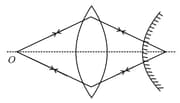
Parallel beam of light is incident on a system of two convex lenses of focal lengths and . What should be the distance between the two lenses so that rays after refraction from both the lenses pass undeviated
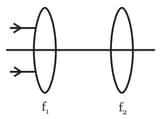
A spherical thick shell made of transparent material is cut along its chord as shown. The smaller part will
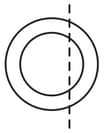
When the object is at distances u1 and u2 the images formed by the same lens are real and virtual respectively and of the same size. Then focal length of the lens is
A beam of diameter 'd' is incident on a glass hemisphere as shown. If the radius of curvature of the hemisphere is very large in comparison to d, then the diameter of the beam at the base of the hemisphere will be
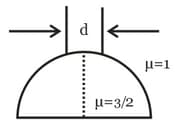
A beam of diameter is incident on a glass hemisphere as shown. If the radius of curvature of the hemisphere is very large in comparison to , then the diameter of the beam at the base of the hemisphere will be
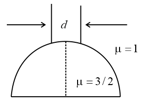
A fish is near the centre of a spherical fishbowl filled with water (). A child is standing at a distance of from the centre of the bowl, where is the radius of curvature of the bowl. The distance from the centre of the fishbowl, where the child's nose will appear to the fish is
A concave spherical surface of radius of curvature 10 cm separates two medium x & y 0f refractive index 4/3 & 3/2 respectively. If the object is placed along principal axis in medium X then
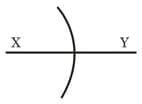
A ray is incident on a glass sphere as shown. The opposite surface of the sphere is partially silvered. If the net deviation of the ray transmitted at the partially silvered surface is 1/3rd of the net deviation suffered by the ray reflected at the partially silvered surface (after emerging out of the sphere). Find the refractive index of the sphere.
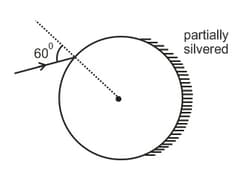
A thin convex lens forms a real image of a certain object 'p' times its size. The size of real image becomes 'q' times that of object when the lens is moved nearer to the object by a distance 'a' find focal length of the lens?
An objective is kept at a distance of from a thin lens and the image formed is real. If the object is kept at a distance of from the same lens the image formed is virtual. If the size of the images formed are equal, then find the focal length of the lens?
A double convex lens has focal length of in air. The radius of one of the surfaces is double of the other. Find the radii of curvature, if the refractive index of the material of the lens is .
Two thin lenses of power +6D and –2D are in contact. The focal length of the combination would be:
Two thin lenses of power and are in contact. The focal length of the combination?
Which of the following expression is correct for :
Taking the rays as incident from a medium of refractive index to another of refractive index
